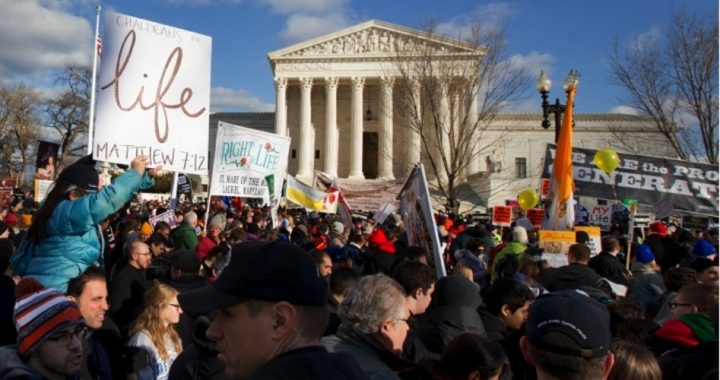
An estimated 500,000 to 800,000 pro-life activists from across the country — blessed with unseasonably mild weather and a newly energized base of supporters — participated in the 42nd annual March for Life in Washington, D.C. on January 22.
The first March for Life was held on January 22, 1974, the first anniversary of the Roe v. Wade Supreme Court decision, and drew an estimated 20,000 supporters. The march, which would grow in numbers over the years and become the most well known rallying point for pro-lifers, was founded by the late Nellie Gray, who retired from her law practice following Roe and spent the rest of her life as a pro-life activist.
Roe v. Wade, decided simultaneously with a companion case, Doe v. Bolton, found that a right to privacy under the due process clause of the 14th Amendment extended to a woman’s decision to have an abortion. Contrary to what many people believe, Roe did not legalize abortion, but nullified most state laws restricting the practice. In that regard, abortion became not only a life issue, but also a states’ rights issue.
Each year, before the march begins, its organizers welcome a number of prominent individuals to speak at a gathering on the National Mall. This year’s speakers included Reverend Joseph Kurtz, president of the U.S. Conference of Catholic Bishops; Carl Anderson, supreme knight of the Knights of Columbus; Representatives Cathy McMorris Rodgers (R-Wash.), Chris Smith (R-N.J.), Daniel Lipinski (D-Ill.); Senator Tim Scott (R-S.C.), and Reverend Sammy Rodriguez, of the National Hispanic Christian Leadership Conference (who has been called “The leader of the Hispanic Evangelical movement”).
Scott drew immediate attention as he took the microphone on the platform, since he is the only black senator who has declared himself to be firmly pro-life. A statement posted on Scott’s Senate website notes: “I am strongly pro-life, supporting the Child Interstate Abortion Notification Act, Pain-Capable Unborn Child Protection Act, and the No Taxpayer Funding for Abortion Act. Since Roe vs. Wade, more than 50 million Americans have never had the opportunity to touch our soil, and that is a tremendous tragedy.”
Smith, who along with another speaker at the rally, Democrat Daniel Lipinski, serves as co-chair of the Bipartisan Congressional Pro-life Caucus, has been a perennial favorite at the March for Life during his three decades in Congress. He used his time to urge the marchers to contact their representatives immediately and urge them to support H.R. 7, to prohibit all taxpayer funding for abortion. Smith was the original sponsor of H.R. 7, which was passed by the House within the hour, by a vote of 242-179. Should the bill pass the Senate, however, President Obama will almost certainly veto it. The president issued a statement on January 22 in which he mentioned the legislation specifically, telegraphing his intentions:
I am deeply committed to protecting this core constitutional right [to abortion], and I believe that efforts like H.R. 7, the bill the House considered today, would intrude on women’s reproductive freedom and access to health care and unnecessarily restrict the private insurance choices that consumers have today.
As noted in yesterday’s article by Jack Kenny, the passage of H.R. 7 closely followed a decision by House Republicans to abandon H.R. 36, the “Pain Capable Unborn Child Protection Act,” a bill to ban most abortions after 20 weeks of pregnancy, the point where it is said the unborn infant can feel pain. Republican leaders had originally scheduled a vote on H.R. 36 for the 22nd, but cancelled the vote after some Republicans complained that the exception for rape applied only when the rape was reported to police.
LifeNews reported on January 21 that Representatives Renee Ellmers (R-N.C.) Charlie Dent (R-Pa.), and Jackie Walorski (R-Ind.) objected to a vote on the bill on the grounds that its language did not do enough to allow women who have been victimized by rape to have abortions.
Dent, who will not receive any awards for courageous statesmanship, told the National Journal: “I prefer that we avoid these very contentious social issues.”
President Barack Obama left no doubts about his position on fetal pain and has said he’ll veto the Pain-Capable Unborn Child Protection Act — should Republicans in Congress ever muster the fortitude to send it to his desk.
One of the most impressive and forceful speakers at yesterday’s pre-march rally, in this writer’s opinion, was also the youngest — Julia Johnson, a senior at Shanley High School in Fargo, North Dakota. Shanley is a Catholic high school with about 320 students that closed so that the entire student body and faculty could travel by bus to Washington for the march. In recognition of this effort, the school’s students were given the privilege of carrying the avenue-wide banner at the head of the march.
Another young woman who participated in the March for Life was Marisa Eddlem, a college student from Massachusetts who was marching for her fourth year in a row. In an e-mail interview Eddlem told us that every year she is “amazed at the [large number] of people who are willing to brave the cold, and some of us miss classes, in order to stand up for every person’s right to life.”
When we asked Eddlem about the age range of most of the marchers, she told us: “Our parish had one as young as eight, and I saw a woman in her nineties. The majority of those on the walk are teenagers. Most of them go with their school or parish.” When asked if she agreed with an observation made by many that today’s young people are becoming more pro-life than previous generations, Eddlem replied: “I would definitely say that this generation is the pro-life generation that you described. Our cheers and liveliness on the march show a passion and youthful energy [in] the pro-life movement that I am so proud to be a part of.”
The annual March for Life is without question an important morale builder for the pro-life movement and sends a strong message to our leaders in Washington that the army of Americans who are willing to stand up for life is getting larger and stronger. The march is the lasting legacy of its founder, Nellie Gray, who said at the 2012 march that the Roe v. Wade decision was “an evil imposed upon our country” and that “the government must understand that they are participating in a crime against humanity which cannot be made legal.”
Such stellar principles did not automatically give Gray knowledge of the best political strategy for stopping abortion in our nation, however. As we noted in our 2009 coverage of that year’s March for Life, as much as we admired Gray for the tremendous effort she put into the pro-life movement, we disagreed with the advice she gave to those who attended that year’s rally. She told “the troops” that the battle for life had to be won at the federal level and that it was not enough to send the issue back to the states, where abortion could be legal in one state and illegal in the next.
However, Gray’s strategy overlooked the fact that abortion, like other crimes, was criminalized on the state level prior to Roe v. Wade. In fact, it was Roe v. Wade that interjected the federal government into the abortion issue in the first place and at the same time made abortion on demand legal throughout the United States. We noted that federal involvement in the abortion issue had resulted in a holocaust of 50 million pre-born babies since 1973. Therefore, why have pro-life leaders largely rejected a return to the pre-1973 approach of prohibiting abortion on the state level in favor of more federal “solutions”?
The answer, we still maintain, is not to grant more power to the federal government in an attempt to restrict abortion. Given the political climate in this country for the foreseeable future, any restrictions pro-lifers are able to get passed by Congress will be minor, and those that have any meat in them will be stopped dead in their tracks, just as the Pain-Capable Unborn Child Protection Act was the other day.
Fortunately, there exists a simpler, more practical strategy to protect life (and other things we cherish), provided for in Article III, Section 2 of the U.S. Constitution. This section allows Congress to strip the Supreme Court of any cases (e.g., abortion cases) where the Supreme Court does not possess original jurisdiction. Congress can also limit the jurisdiction of any lower federal courts, since Congress created those courts. Congress could make Roe v. Wade a nonproblem overnight, since by prohibiting the federal courts from hearing abortion cases the states could then put back in place anti-abortion laws.
This strategy was attempted by former Representative Ron Paul (R-Texas) in the 111th Congress as H.R. 539, the “We the People Act.” H.R. 539 would have removed the jurisdiction of the Supreme Court and other federal courts from cases related to the free exercise or establishment of religion; the right of privacy, including any such claim related to any issue of sexual practices, orientation, or reproduction (e.g., abortion); and the right to marry without regard to sex or sexual orientation (same-sex marriage).
It also would have prohibited the federal courts from relying on any judicial decision involving any issue referred to in the above list. In other words, it would remove Roe v. Wade and similar decisions from judicial precedent.
However, not one major national pro-life organization supported Paul’s legislation, which was the only solution that might have accomplished a substantial reduction in abortions. Marches and rallies are wonderful tools in the pro-life battle, but such resources must be used to support meaningful political action. When it comes down to it, the battle for life will be won or lost on the legislative playing field, as Paul was willing to do. It is not an either/or approach. It requires education and action. Pro-lifers must help eductate the electorate about the evils of abortion, then support legislation that will accomplish their goals — and it must be done by reducing federal power, not increasing it.
Photo of March for Life: AP Images
Related articles:
House GOP Drops One Abortion Bill, Passes Another, As March For Life Fills D.C. Streets
Pro-Lifers in 41st March for Life Brave Harsh Conditions
Pro-Life Events Across Nation Mark 40th Anniversary of Roe v. Wade
Pro-Life Leaders Pay Tribute to “March for Life” Founder Nellie Gray



